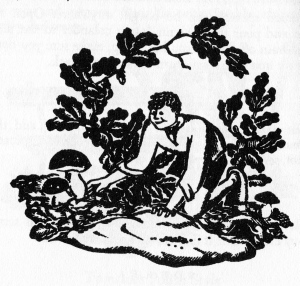Mushroom Pies
Four individual pies.
The Editor and those who dine with her like mushrooms and they like pies. Along with Elisabeth Ayrton and other right thinking people, the Editor herself likes the convenience (not necessarily a term of derision) of frozen puff pastry. It sounds like a familiar boast of happily busy home cooks, but most of the ingredients were lounging about in danger of spoilage and this recipe was the congenial result. The Editor’s own. You will need ramekins of something like a six inch diameter, more or less.
Preheat the oven to 425°

- 2 sheets of (thawed) frozen puff pastry
- 4 slices bacon, cut crosswise into roughly ¼ inch batons
- a handful of tiny whole onions (frozen are fine once thawed)
- unsalted butter if needed
- a Portobello mushroom, stripped of its gills ( see the Notes) and cut into ½ inch cubes
- ½ big onion (about a cup) sliced into thin crescents
- 2 minced shallots
- 4-6 scallions, white and green separated and minced
- a generous cup of sliced mushrooms (your preference, ours is cremini)
- heaped ½ teaspoon dried thyme
- 2 Tablespoons flour
- 2 bay leaves
- about ½ cup mushroom stock ( see the Notes)
- 2 teaspoons mushroom ketchup (preferred) or Worcestershire or a combination of them
- 1 teaspoon steak sauce (like ‘London Pub’, HP or A-1)
- 1 Tablespoon minced parsley
- Cook the bacon in a heavy skillet over medium low heat until it renders its fat and turns crisp: Remove it from the skillet leaving behind as much of the grease as you can.
- Increase the heat to high, throw the whole onions into the skillet and cook them until they almost scorch in spots, then remove the whole onions too.
- Add the Portobello chunks to the skillet, seer them briefly, and remove them from the pan.
- Add an appropriate amount of butter to the skillet if most (or all) of the bacon fat has been absorbed by the previous batches, and then sear the sliced mushrooms. Remove them too.
- If necessary, add an appropriate amount of butter to the skillet, then cook the sliced onion, shallots and scallion whites until they soften.
- Stir the thyme into the onions, dust the onions evenly with flour, add the bay leaves and stir the mess until the flour loses its raw color.
- Add a little stock to keep the flour from burning, followed by about half the stock.
- Return all the removals to the skillet, pour on the ketchup and sauce, stir to combine everything into a most savory filling, and add enough additional stock to create a slightly thickened gravy. Swirl the green scallions and parsley amidst the mushrooms, turn off the heat and check the .... for salt and pepper.
- Using the base of a ramekin for a template, cut four rounds of pastry that are about ¾ inch greater in diameter than your template.
- Spoon the filing into the ramekins, cover them with the parsley and crimp it at right angles to the ramekins to anchor the pastry.
- Cut some vents in the pastry, decorate it with scraps left from cutting the rounds and put the ramekins on a cookie sheet.
- Bake the pies until the pastry swells and turns gold, usually in about 15-20 minutes.
Notes:
- In an iteration of the fabulously obvious, this recipe turns vegetarian through omission of the bacon. Start the process with neutral or olive oil instead of bacon and its fat. The flavour will differ from the recipe, however, and not in a better way.
- Any mushrooms will do, and chanterelles are particularly good in season if (and only if) you are feeling flush.
- Be careful not to oversalt these pies. The bacon, mushroom ketchup and steak sauces can get sneaky salty by the end of the recipe.
- As usual the Editor cannot resist a splash of hot sauce (at step 7).
- Susan Spicer notes in Crescent City Cooking (New York 2007) that the gills on the underside of Portobello mushrooms tend to induce steaming and retard searing, so she amputates them from the cap with a spoon. This is a sound practice, not just to color your mushrooms but also because there is nothing particularly pleasant about the texture of the cooked gills.
- We are not ordinarily enamored of the over-exposed and frequently misspelled Portobello. The big puffy discs are difficult to sear and all too often turn mucky instead (even without the pesty gills), but their texture, carefully cultivated over very high heat, enhances the texture of these pies.
- The amount of stock for use in this recipe is left ambiguous for good reason. Mushrooms can go through a variable and sometimes large amount of liquid during and even after cooking as they rest while you continue to build your pie filling. Liquid in the pan is undesirable: You are boiling your mushrooms because the heat is insufficiently high. In any event followers of this recipe must exercise common sense, a salutary practice anyway, in adding their stock.
“This is one of the sauces we make better in England than in France, for the French don’t make bread sauce at all--a great mistake on their part, for properly made it is excellent, not only with birds but with many kinds of fish.” The Gentle Art of Cookery 9 (London 1925)
- They use half a dozen cloves and add a step to their recipe: “The bread crumbs should be stale, dried in the oven and then pounded.” ( Gentle Art 9) Not necessary.

